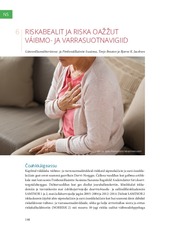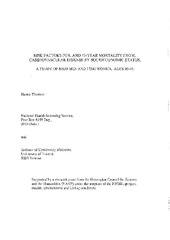Browsing Artikler, rapporter og annet (samfunnsmedisin) by Title
Now showing items 1132-1151 of 1394
-
Resting heart rate trajectories and myocardial infarction, atrial fibrillation, ischaemic stroke and death in the general population: The Tromso Study
(Journal article; Tidsskriftartikkel; Peer reviewed, 2017-01-25)Background: <br>Resting heart rate (RHR) is an established risk factor for cardiovascular disease (CVD), but long-term individual RHR trajectories and their effect on CVD morbidity and mortality have not yet been described. <br> Methods: <br>This large population-based longitudinal study included 14,208 men and women aged 20 years or older, not pregnant, and not using blood pressure medications, ... -
Rethinking the carcinogenesis of breast cancer: The theory of breast cancer as a child deficiency disease or a pseudo semi-allograft
(Journal article; Tidsskriftartikkel; Peer reviewed, 2018-08-23)The theory of breast cancer as a <i>child deficiency disease</i> is an <i>inversion of the current paradigm</i>, which considers fullterm pregnancies to be a protective factor and uses nulliparous women as the reference group. Instead, the theory of breast cancer as a child deficiency disease says that women with the highest parity (about 20, which is the limit of human fertility) are those with ... -
The retropubic tension-free vaginal tape procedure—Efficacy, risk factors for recurrence and long-term safety
(Journal article; Tidsskriftartikkel; Peer reviewed, 2019-02-14)<i>Introduction</i> - The retropubic tension‐free vaginal tape has been the preferred method for primary surgical treatment of stress urinary incontinence and stress‐dominated mixed urinary incontinence in women for more than 20 years. This study presents long‐term safety and efficacy data and assesses risk factors for long‐term recurrence.<p> <p><i>Material and methods</i> - In a case‐series ... -
Retrospectively reported childhood adversity is associated with asthma and chronic bronchitis, independent of mental health
(Journal article; Tidsskriftartikkel; Peer reviewed, 2018-09-13)Several researchers have raised the concern that the cross-sectional association of retrospectively reported childhood adversity with self-reported onset of asthma and chronic bronchitis in adulthood may be confounded, as well as mediated by an individual's mental health. The aim of this study was to assess the effect of retrospectively reported childhood adversity on self-reported onset of asthma ... -
Risikofaktorer og risiko for hjerte- og karsykdommer
(Chapter; Bokkapittel, 2022-03-16)Kapittelet beskriver risiko for hjerte- og karsykdommer blant samer og ikke-samer i Nord-Norge og bygger i hovedsak på tre artikler som er inkludert i doktorgradsavhandlingen til Susanna Ragnhild Andersdatter Siri. Datagrunnlaget er informasjon fra spørreskjema, kliniske undersøkelser og blodprøver som ble samlet inn ved helse- og levekårsundersøkelsene SAMINOR 1 og 2, som ble utført i henholdsvis ... -
Rising Sun: Prioritized outcomes for suicide prevention in the Arctic
(Journal article; Tidsskriftartikkel; Peer reviewed, 2018-10-24)The Arctic Council, a collaborative forum among governments and Arctic communities, has highlighted the problem of suicide and potential solutions. The mental health initiative during the United States chairmanship, Reducing the Incidence of Suicide in Indigenous Groups: Strengths United Through Networks (RISING SUN), used a Delphi methodology complemented by face-to-face stakeholder discussions to ... -
Risk Factors for hypospadias in Northwest Russia: A Murmansk County Birth Registry Study
(Journal article; Tidsskriftartikkel; Peer reviewed, 2019-04-04)<i>Background</i> - Hypospadias is the most common congenital anomaly of the penis, but its causes are mainly unknown. Of the risk factors identified, the most plausible are hormonal and genetic. The aim of this study was to identify risk factors for hypospadias in Northwest Russia based on registry data.<p> <p><i>Methods</i> - The study population included male infants registered in the Murmansk ... -
Risk factors for perinatal mortality in Murmansk County, Russia: a registry-based study
(Journal article; Tidsskriftartikkel; Peer reviewed, 2017-01-27)Background: Factors contributing to perinatalmortality (PM) in Northwest Russia remain unclear. This study investigated possible associations between selected maternal and fetal characteristics and PM based on data from the population-based Murmansk County Birth Registry. <br> Objective: This study investigated possible associations between selected maternal and fetal characteristics and PM ... -
Risk factors for type 2 diabetes in groups stratified according to metabolic syndrome : a 10-year follow-up of The Tromsø Study
(Journal article; Tidsskriftartikkel; Peer reviewed, 2010)Many incident cases of type 2 diabetes do not fulfill the metabolic syndrome, which accordingly has been questioned both as a research and clinical tool. The aim of this study was to determine differences in risk factors for type 2 diabetes between groups with high or low metabolic score. The study population were 26,093 men and women attending the Tromsø Study in 1994, followed through 2005, and ... -
Risk factors for type 2 diabetes in groups stratified according to metabolic syndrome: a 10-year follow-up of The Tromso Study
(Journal article; Tidsskriftartikkel; Peer reviewed, 2010-12-28)Many incident cases of type 2 diabetes do not fulfil the metabolic syndrome, which accordingly has been questioned both as a research and clinical tool. The aim of this study was to determine differences in risk factors for type 2 diabetes between groups with high or low metabolic score. The study population were 26,093 men and women attending the Tromsø Study in 1994, followed through 2005, ... -
Risk Factors for Ventricular Septal Defects in Murmansk County, Russia: A Registry-Based Study
(Journal article; Tidsskriftartikkel; Peer reviewed, 2018-06-24)Cardiovascular malformations are one of the most common birth defects among newborns and constitute a leading cause of perinatal and infant mortality. Although some risk factors are recognized, the causes of cardiovascular malformations (CVMs) remain largely unknown. In this study, we aim to identify risk factors for ventricular septal defects (VSDs) in Northwest Russia. The study population ... -
Risk factors for, and 13-year mortality from, cardiovascular disease by socioeconomic status : a study of 44690 men and 17540 women, ages 40-49.
(Research report; Forskningsrapport, 1993) -
Risk factors of anemia among preschool children in Ethiopia: a Bayesian geo-statistical model
(Journal article; Tidsskriftartikkel; Peer reviewed, 2022-01-07)Background - The etiology and risk factors of anemia are multifactorial and varies across context. Due to the geospatial clustering of anemia, identifying risk factors for anemia should account for the geographic variability. Failure to adjust for spatial dependence whilst identifying risk factors of anemia could give spurious association. We aimed to identify risk factors of anemia using a Bayesian ... -
Risk Factors, Subsequent Disease Onset, and Prognostic Impact of Myocardial Infarction and Atrial Fibrillation
(Journal article; Tidsskriftartikkel; Peer reviewed, 2022-03-24)BACKGROUND: Although myocardial infarction (MI) and atrial fibrillation (AF) are frequent comorbidities and share common cardiovascular risk factors, the direction and strength of the association of the risk factors with disease onset, subsequent disease incidence, and mortality are not completely understood.<p> <p>METHODS AND RESULTS: In pooled multivariable Cox regression analyses, we examined ... -
Risk of early-onset prostate cancer associated with occupation in the Nordic countries
(Journal article; Tidsskriftartikkel, 2017-11-10)Background: <br>Early-onset prostate cancer is often more aggressive and may have a different etiology than later-onset prostate cancer, but has been relatively little studied to date. We evaluated occupation in relation to early-onset and later-onset prostate cancer in a large pooled study. <br>Methods: <br>We used occupational information from census data in five Nordic countries from 1960-1990. ... -
Risk of lung cancer and physical activity by smoking status and body mass index, the Norwegian Women and Cancer Study
(Journal article; Tidsskriftartikkel; Peer reviewed, 2018-10-01)We aimed to investigate physical activity (PA) and risk of different histological subtypes of lung cancer according to smoking status and body mass index using repeated measurements in a large cohort of women in Norway. The study sample for the multiple imputation analyses consisted of 86,499 and for the complete-case analysis 80,802 women. Repeated measurements of PA level, smoking habits, weight, ... -
Risk of malnutrition and zinc deficiency in community-living elderly men and women: the Tromsø Study
(Journal article; Tidsskriftartikkel; Peer reviewed, 2014-11-06) -
Risk prediction for estrogen receptor-specific breast cancers in two large prospective cohorts
(Journal article; Tidsskriftartikkel; Peer reviewed, 2018-12-03)<p><i>Background</i>: Few published breast cancer (BC) risk prediction models consider the heterogeneity of predictor variables between estrogen-receptor positive (ER+) and negative (ER-) tumors. Using data from two large cohorts, we examined whether modeling this heterogeneity could improve prediction.</p> <p><i>Methods</i>: We built two models, for ER+ (Model<sub>ER+</sub>) and ER- tumors ... -
Risk prediction of atrial fibrillation and its complications in the community using hs troponin I
(Journal article; Tidsskriftartikkel; Peer reviewed, 2023-01-05)Aims - Atrial fibrillation (AF) is becoming increasingly common. Traditional cardiovascular risk factors (CVRF) do not explain all AF cases. Blood-based biomarkers reflecting cardiac injury such as high-sensitivity troponin I (hsTnI) may help close this gap.<p> <p>Methods - We investigated the predictive ability of hsTnI for incident AF in 45,298 participants (median age 51.4 years, 45.0% men) ... -
Risk thresholds for alcohol consumption: combined analysis of individual-participant data for 599 912 current drinkers in 83 prospective studies
(Journal article; Tidsskriftartikkel; Peer reviewed, 2018-04-12)<p><i>Background - </i>Low-risk limits recommended for alcohol consumption vary substantially across different national guidelines. To define thresholds associated with lowest risk for all-cause mortality and cardiovascular disease, we studied individual-participant data from 599 912 current drinkers without previous cardiovascular disease. <p><i>Methods - </i>We did a combined analysis of ...


 English
English norsk
norsk


















